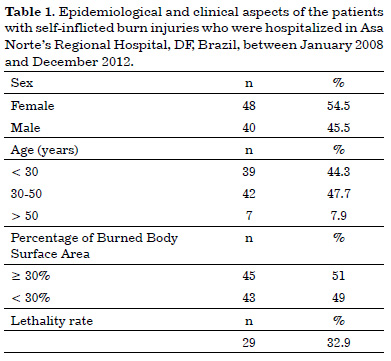ABSTRACT
INTRODUCTION: Self-inflicted burn injuries lead to physical, psychological, and economic consequences not only to the victims but also to their families and the society. The prevalence of this type of accident varies greatly throughout the existing literatures. This study aimed to analyze the epidemiological profile, behavior, and lethality rate in patients with self-inflicted burn injuries who received treatment in a burn unit, as a way to contribute to the effective intervention to minimize the effects of risk factors and behaviors associated with this type of accident.
METHOD: We conducted a retrospective study in which we analyzed medical records of patients hospitalized in the burn unit of Asa Norte's Regional Hospital, DF, Brazil, during the period between January 2008 and December 2012.
RESULTS: The study sample consisted of 88 patients with self-inflicted burn injuries, of whom 54.5% were female, with a mean age of 33 years and mean burned body surface area of 36%. The mean hospitalization time was 23 days. Open flame was the etiological agent in 97.7% of the burn cases, and alcohol was the accelerating agent in 68.2% of these cases. The lethality rate was 32.9%. Sixty patients had comorbidities, with psychiatric disorders and alcoholism being the most common.
CONCLUSION: The patients with self-inflicted burn injuries were generally women, with a mean age of 33 years, who used alcohol as accelerating agent. The mean body surface area affected was 36%. Of the patients, 32.9% had associated psychiatric disorders. The lethality rate was 32.9%. From a social perspective, public measures should be established to detect potential patients in order to administer appropriate therapies.
Keywords: Burn injuries; Self-destructive behavior; Suicide; Burn units.








